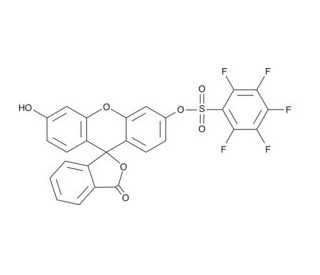

Pentafluorobenzenesulfonyl fluorescein (CAS 728912-45-6)
See product citations (9)
QUICK LINKS
Pentafluorobenzenesulfonyl fluorescein is a chemically modified variant of fluorescein, widely recognized for its application in fluorescent labeling techniques in molecular biology and biochemical research. This compound leverages the intrinsic properties of fluorescein, known for its robust photostability and intense fluorescence under blue light excitation, but is modified to increase its reactivity and specificity towards target molecules. The pentafluorobenzenesulfonyl group enhances the molecule′s electrophilic character, facilitating its conjugation to various biomolecules, including proteins, nucleic acids, and lipids, through sulfonamide or ester linkages. This characteristic makes it an invaluable tool in the study of cellular processes, allowing for real-time visualization of dynamic biological interactions and pathways with high spatial and temporal resolution. The unique properties of pentafluorobenzenesulfonyl fluorescein make it particularly useful in applications such as fluorescence microscopy, flow cytometry, and fluorescence resonance energy transfer (FRET) experiments, where it contributes to a deeper understanding of cellular and molecular mechanics.
Pentafluorobenzenesulfonyl fluorescein (CAS 728912-45-6) References
- Recent advances in fluorescent probes for the detection of reactive oxygen species. | Soh, N. 2006. Anal Bioanal Chem. 386: 532-43. PMID: 16609844
- Visfatin induces oxidative stress in differentiated C2C12 myotubes in an Akt- and MAPK-independent, NFkB-dependent manner. | Oita, RC., et al. 2010. Pflugers Arch. 459: 619-30. PMID: 19898975
- Hydrogen peroxide promotes injury-induced peripheral sensory axon regeneration in the zebrafish skin. | Rieger, S. and Sagasti, A. 2011. PLoS Biol. 9: e1000621. PMID: 21629674
- Trichostatin A inhibits transforming growth factor-β-induced reactive oxygen species accumulation and myofibroblast differentiation via enhanced NF-E2-related factor 2-antioxidant response element signaling. | Yang, L., et al. 2013. Mol Pharmacol. 83: 671-80. PMID: 23284002
- Oxidative stress-dependent MMP-13 activity underlies glucose neurotoxicity. | Waldron, AL., et al. 2018. J Diabetes Complications. 32: 249-257. PMID: 29306589
- The role of reactive oxygen species in pollen germination in Picea pungens (blue spruce). | Maksimov, N., et al. 2018. Plant Reprod. 31: 357-365. PMID: 29619606
- A fluorescence assay for the detection of hydrogen peroxide and hydroxyl radicals generated by metallonucleases. | Leichnitz, S., et al. 2018. Chem Commun (Camb). 54: 13411-13414. PMID: 30427336
- A fluorescent approach for detecting and measuring reduction reaction byproducts near cathodically-biased metallic surfaces: Reactive oxygen species production and quantification. | Wiegand, MJ., et al. 2019. Bioelectrochemistry. 129: 235-241. PMID: 31226524
- Dual roles of hydrogen peroxide in promoting zebrafish renal repair and regeneration. | Chen, J., et al. 2019. Biochem Biophys Res Commun. 516: 680-685. PMID: 31248596
- Developing a Silk Fibroin Composite Film to Scavenge and Probe H2O2 Associated with UV-Excitable Blue Fluorescence. | Chung, TW., et al. 2020. Sensors (Basel). 20: PMID: 31936424
- Precision targeting of bacterial pathogen via bi-functional nanozyme activated by biofilm microenvironment. | Huang, Y., et al. 2021. Biomaterials. 268: 120581. PMID: 33302119
- Oxygen radicals and cytoplasm zoning in growing lily pollen tubes. | Podolyan, A., et al. 2021. Plant Reprod. 34: 103-115. PMID: 33492520
- Nicotinamide suppresses bevacizumab-induced epithelial-mesenchymal transition of ARPE-19 cells by attenuating oxidative stress. | Zhou, L., et al. 2021. Int J Ophthalmol. 14: 481-488. PMID: 33875936
Ordering Information
| Product Name | Catalog # | UNIT | Price | Qty | FAVORITES | |
Pentafluorobenzenesulfonyl fluorescein, 1 mg | sc-205429 | 1 mg | $73.00 | |||
Pentafluorobenzenesulfonyl fluorescein, 5 mg | sc-205429A | 5 mg | $310.00 |
